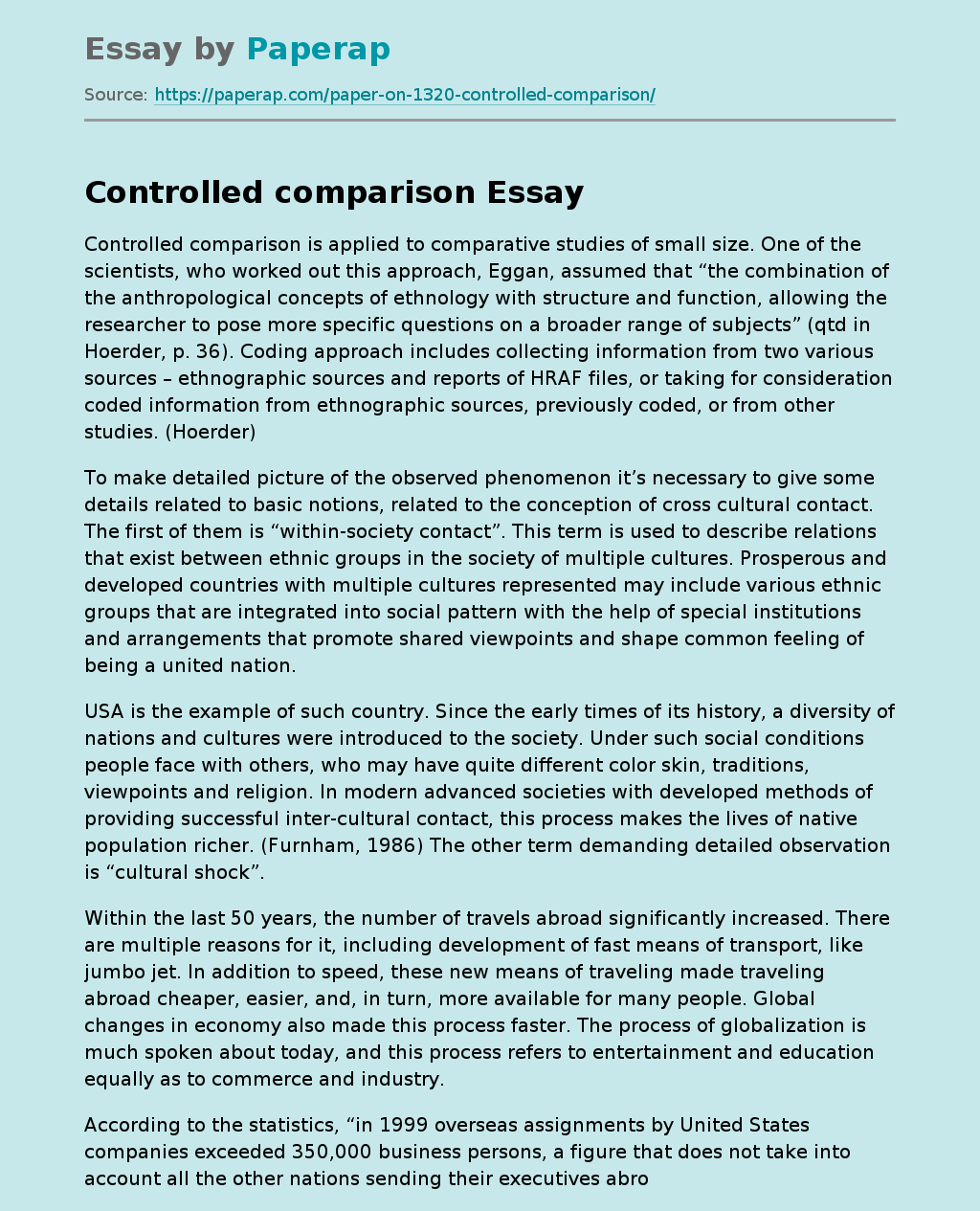Individualism Collectivism: Controlled Comparison
Controlled comparison is applied to comparative studies of small size. One of the scientists, who worked out this approach, Eggan, assumed that “the combination of the anthropological concepts of ethnology with structure and function, allowing the researcher to pose more specific questions on a broader range of subjects” (qtd in Hoerder, p. 36). Coding approach includes collecting information from two various sources – ethnographic sources and reports of HRAF files, or taking for consideration coded information from ethnographic sources, previously coded, or from other studies.
(Hoerder)
To make detailed picture of the observed phenomenon it’s necessary to give some details related to basic notions, related to the conception of cross cultural contact. The first of them is “within-society contact”. This term is used to describe relations that exist between ethnic groups in the society of multiple cultures. Prosperous and developed countries with multiple cultures represented may include various ethnic groups that are integrated into social pattern with the help of special institutions and arrangements that promote shared viewpoints and shape common feeling of being a united nation.
USA is the example of such country. Since the early times of its history, a diversity of nations and cultures were introduced to the society. Under such social conditions people face with others, who may have quite different color skin, traditions, viewpoints and religion. In modern advanced societies with developed methods of providing successful inter-cultural contact, this process makes the lives of native population richer. (Furnham, 1986) The other term demanding detailed observation is “cultural shock”.
Within the last 50 years, the number of travels abroad significantly increased. There are multiple reasons for it, including development of fast means of transport, like jumbo jet. In addition to speed, these new means of traveling made traveling abroad cheaper, easier, and, in turn, more available for many people. Global changes in economy also made this process faster. The process of globalization is much spoken about today, and this process refers to entertainment and education equally as to commerce and industry.
According to the statistics, “in 1999 overseas assignments by United States companies exceeded 350,000 business persons, a figure that does not take into account all the other nations sending their executives abroad. It has been estimated that at any given time there are about a million and a half students and scholars attending educational institutions abroad. The figures for tourists are even greater: The World Tourism Organisation has projected that by the year 2010 the number of international tourist-related journeys will rise to a total of 940 million trips per year.” (Hoerder, p. 98) The notion of cultural shock was first used by Kalervo Oberg, anthropologist, who applied it to describe people’s reaction to strange surroundings.
The other scientists, that continued to study this condition, offer not to understand it literally: “that it reflects some of the feelings and experiences of travelers who suddenly find themselves in new, strange, or unfamiliar places. The unknown can be an uncomfortable and at times terrifying experience.
However, the use of the word “shock” places too much emphasis on the threatening circumstances of contact with novel situations, without acknowledging that such experiences may also have beneficial consequences for the participants. ” (Hoerder, p. 88) In the cultural dimension several theories have been created to explain the differences between the personalities in the cross cultural aspect. Considering these theories critically, it should be assumed that they have not been created without any reason, and there have existed solid grounds to assume that depending on what culture of origin is the source of social patterns for the personality, it is possible to define the basic criteria of personality characteristics.
For example, the theory created by Hoerder states that ‘the cultures endow individuals with different principles that influence behavior. ‘ The author of this theory argued that one of the cultural dimensions is always measured through the line of individualism versus collectivism, and these traits should be included into the set of basic characteristics peculiar of the personality in the cross cultural perspective.
Individualism Collectivism: Controlled Comparison. (2017, May 26). Retrieved from https://paperap.com/paper-on-1320-controlled-comparison/

